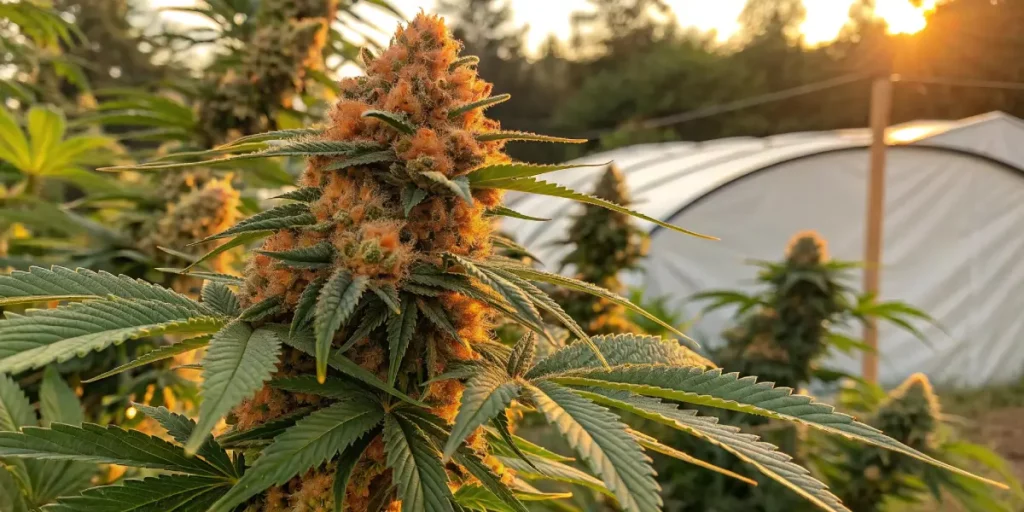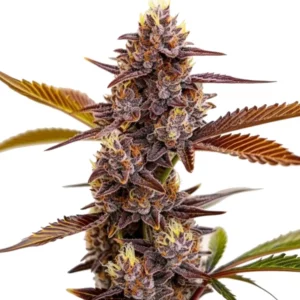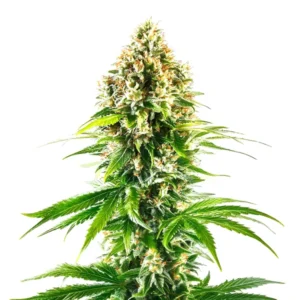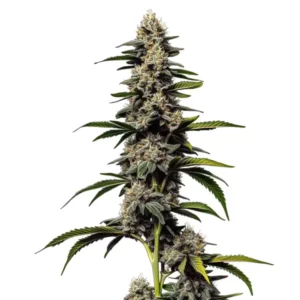Orange Cookie Strain Description
The Orange Cookies Strain is a highly revered cannabis hybrid, celebrated for its unique blend of flavors and well-rounded effects. This strain has carved out a niche among both recreational users and those seeking medicinal benefits. It is a product of crossing Sonic’s Orange with Cookie x Cream (Starfighter x Girl Scout Cookies), bringing together a genetic lineage that balances its hybrid nature beautifully.
Recommended Strains
Orange Cookies
 THC: 18 - 22%
THC: 18 - 22% Type of seed: Feminized
Type of seed: Feminized Phenotype: Mostly Hybrid
Phenotype: Mostly Hybrid Day to flower: 8 - 10 weeks
Day to flower: 8 - 10 weeks
This strain typically presents medium THC levels, ranging from 18% to 22%, which makes it potent but not overwhelming, making it ideal for orange cookies THC users. The strain showcases a dazzling mix of physical characteristics, with dense buds that display shades of bright green interspersed with fiery orange hairs. The surface of the buds glistens with a frosty layer of trichomes, giving them a sticky, resinous feel.
What truly sets Orange Cookies cannabis apart is its remarkable flavor profile. The aroma is dominated by a fresh citrus scent, closely reminiscent of a sweet, ripe orange, while the taste carries a creamy vanilla undertone, making every puff a delightful experience. The terpene profile includes Alpha Humulene, Alpha-Pinene, and Beta-Caryophyllene, contributing to its distinctive aromatic and flavor characteristics.
Promos & Deals
Environmental Requirements for Growing Orange Cookie Strain
To cultivate the orange frosted cookies strain successfully, knowing its environmental needs is essential. This strain thrives in a balanced climate with daytime temperatures ranging between 70-80°F (21-27°C) and slightly cooler nights. Maintaining stable temperature and humidity levels in the grow space is important to prevent stress and avoid mold or mildew, which can severely impact the plants.
For indoor cultivation, it’s crucial to provide adequate lighting. High-quality LED grow lights or HPS lamps are recommended to support robust vegetative growth and dense bud formation. During the vegetative stage, its benefits from a light cycle of 18-20 hours of light per day. When transitioning to the flowering phase, switch to a 12/12 light cycle to encourage bud development.
Outdoor growers should choose a location that offers plenty of sunlight and a favorable climate. It can flourish in a warm, sunny environment, maximizing its potential yield. For regions with cooler climates, utilizing a greenhouse or providing extra protection can extend the growing season and safeguard the plants from harsh weather conditions.
Setting Up The Growing Cannabis Space
Indoor Cannabis Cultivation
When cultivating cookie strain seeds indoors, choosing the right grow tent or dedicated space is essential. The area should allow enough vertical growth and have proper ventilation to maintain fresh airflow. Installing an efficient exhaust system with a carbon filter will help control odors and prevent the buildup of heat and humidity. Reflective materials or Mylar sheets are ideal for maximizing light distribution, ensuring even growth, and preventing light leaks during the critical flowering phase.
Regarding the growing medium, options such as high-quality soil or hydroponic systems can be considered based on personal preference and experience level. It’s crucial to ensure good drainage to avoid waterlogging, which can lead to root rot. Maintaining a pH level of around 6.0-6.5 in the growing medium will facilitate optimal nutrient absorption, leading to healthier plants and better yields.
Outdoor Cannabis Cultivation
For outdoor cultivation of this strain, select a site with ample sunlight and well-draining soil rich in organic matter. Using large containers or fabric pots can offer better control over soil quality and root health. Additionally, providing stakes or trellises can support the plant branches, especially when the buds grow denser and heavier, helping to avoid breakage and improve airflow around the plant.
Protecting the plants from strong winds is also essential. Positioning them near a natural windbreak like a fence or using wind protection methods can ensure the plants remain upright and undamaged, allowing them to grow to their full potential.

Propagation and Germination of Orange Cookie Strain
Germinating and propagating this strain requires a careful approach to ensure healthy seedlings and vigorous growth. Follow these steps to maximize your germination rates and achieve successful propagation:
- Begin with high-quality feminized seeds from a reputable seed bank. This guarantees genetic stability and ensures the feminization of your plants.
- To initiate germination, soak the seeds in distilled water or place them between damp paper towels for 24-48 hours. Maintain a temperature range of 70-85°F (21-29°C) and keep the environment dark and undisturbed to promote sprouting.
- Once the seeds have sprouted and developed taproots, carefully transfer them to a pre-moistened growing medium such as a seedling tray or small pots with a light, well-draining soil mix.
- Maintain a warm and humid environment with gentle airflow. Aim for temperatures around 75-80°F (24-27°C) and humidity levels between 60-70% to encourage successful germination.
- Provide indirect light to the seedlings for the first few days, gradually increasing the light intensity as they grow. Avoid exposing them to intense light or high heat, which could cause stress or damage.
- Once the seedlings develop several sets of true leaves, they are ready for transplantation into larger pots or their final growing containers.
By adhering to these germination and propagation practices, you set a solid foundation for your plants, promoting healthy growth and bountiful yields.
Vegetative Phase of Orange Cookie Strain
The vegetative phase is critical for developing this strain , focusing on strong root systems and foliage growth. Here are some essential considerations during this stage:
Lighting: Provide 18-20 hours of light daily to stimulate vigorous vegetative growth. High-quality LED grow lights or HPS lamps are ideal for ensuring sufficient light intensity and the right spectral distribution for healthy development.
Nutrition: During this stage, a balanced, nutrient-rich diet is essential. Opt for a cannabis-specific fertilizer high in nitrogen (N) to promote healthy leaf and stem growth. Follow the recommended feeding schedule and monitor the plants for any signs of nutrient deficiencies or imbalances, adjusting as needed.
Watering: Ensure proper watering by allowing the top inch of soil to dry out before rewatering. Overwatering can lead to root rot and other moisture-related problems, so it’s crucial to find a balance and prevent excessive dryness or saturation.
Training: Techniques such as low-stress training (LST) or topping can help control plant height and shape. These methods encourage a more even canopy, enhance light penetration, and promote better bud development.
Pruning: Remove any lower branches or leaves that receive insufficient light or show signs of disease or pest infestation. This step improves airflow and reduces the risk of mold or mildew, ensuring a healthier plant overall.
Providing the right environmental conditions, nutrition, and care during the vegetative phase lays the groundwork for a successful flowering stage and a fruitful harvest.
Flowering Phase of Orange Cookie Seeds
The flowering phase is the most exciting stage of growing this strain, where the plants develop their characteristic buds and potent aromas. Here are the key points to focus on:
Lighting: Transition to a 12-hour light and 12-hour dark cycle to trigger the flowering phase. Consistent light schedules are vital, so use a timer to maintain accuracy. The plants need intense light during this stage, so ensure your grow lights provide adequate coverage and are appropriately distanced from the canopy.
Nutrition: Switch from a nutrient formula higher in nitrogen to one designed for flowering, typically higher in phosphorus (P) and potassium (K). These nutrients are crucial for bud development and overall flowering performance. Monitor the plants closely to avoid nutrient deficiencies or toxicities and adjust feeding accordingly.
Temperature and Humidity: Aim for slightly cooler temperatures during flowering, ideally between 65-75°F (18-24°C), to enhance resin production and minimize heat stress. Keep humidity levels around 40-50% to reduce the risk of mold and bud rot, ensuring a healthier, more productive plant.
Support: As this plants begin to flower, the buds’ increasing weight may cause branches to bend or break. Provide adequate support with stakes or trellises to prevent damage and ensure the plants can sustain their weight.
Flowering Time: This strain typically flowers within 8-10 weeks, but this can vary based on phenotype and environmental conditions. Monitor trichome development closely using a magnifying tool to determine the optimal harvest window for the highest potency and best flavor profile.
Maintain vigilance throughout the flowering phase for signs of pests or diseases. Implement effective pest management strategies and address any infestations or issues promptly to protect your Continuing with the content for growing this plants and ensure a successful harvest.
Cannabis Fertilization and Nutrition
Ensuring your plants receive proper nutrition is critical for maximizing growth, yield, and overall plant health. Here are some key guidelines for fertilization and nutrition:
Choosing the Right Fertilizer: Opt for a high-quality, cannabis-specific fertilizer or nutrient line that offers a balanced mix of macro and micronutrients. Products high in nitrogen (N), phosphorus (P), and potassium (K) will support healthy growth, strong roots, and vigorous bud formation. Ensure you select a fertilizer tailored to the specific growth stage (vegetative or flowering) to meet the plant’s changing needs.
Feeding Schedule: Follow the manufacturer’s instructions for your chosen nutrients, adjusting the feeding schedule as necessary based on your plants’ development. Start with a lower concentration to avoid nutrient burn and gradually increase as the plants grow. Regularly monitor your plants for signs of nutrient deficiencies or toxicities, such as yellowing leaves or burnt tips, and adjust nutrient levels accordingly to maintain optimal health.
Supplements and Additives: Consider incorporating supplements to enhance specific aspects of plant growth. Bloom boosters can improve bud density, while beneficial microbes, enzymes, and organic amendments can enhance soil structure and nutrient availability. Adding calcium and magnesium supplements can also prevent common deficiencies in cannabis plants.
Keep a close eye on how your orange pie strain plants respond to the feeding regimen, adjusting nutrient concentrations and frequencies as needed. It’s also vital to flush the plants with pure water in the final weeks of flowering to remove any residual salts or nutrients that could affect the flavor and quality of your buds.
Pest and Disease Control for Cannabis Growing
Despite its resilience, it can still be susceptible to pests and diseases. Implementing effective pest and disease control measures is crucial for protecting your plants and ensuring a bountiful harvest. Here’s how you can safeguard your cannabis garden:
Prevention:
- Regularly inspect your plants for signs of pests, such as spider mites, aphids, or thrips. Early detection is key to preventing infestations from spreading.
- Maintain a clean and tidy grow space, removing any dead plant material or debris that could harbor pests or pathogens.
- Introduce beneficial insects, such as ladybugs or predatory mites, which can naturally control pest populations.
- Ensure proper airflow and ventilation in the grow area to reduce humidity levels, thereby minimizing the risk of mold or mildew development.
- Quarantine new plants or clones before introducing them to your grow area to prevent potential pest or disease transfer.
Corrective Actions:
- If pests are detected, use organic or low-toxicity pest control products designed specifically for cannabis cultivation. Follow the instructions carefully to avoid harming your plants or affecting bud quality.
- For fungal diseases such as powdery mildew or botrytis, remove infected plant material immediately, increase airflow, and consider using organic fungicides or natural remedies like neem oil or milk sprays.
- If infestations or diseases are severe, consult with a professional grower or horticulturist to receive tailored advice and appropriate solutions for your specific situation.
Harvesting and Curing for Cannabis Growing
Harvesting your strain at the right time and curing the buds properly are crucial steps to preserve their aroma, flavor, and potency. Follow these guidelines to ensure a high-quality harvest:
Trichome Maturity: Monitor the trichomes on the buds using a magnifying tool. Harvest when the trichomes have turned a milky or cloudy color with some amber trichomes present, which indicates the optimal balance of cannabinoids and terpenes for peak potency and flavor.
Harvesting: Use clean, sterilized pruning shears or scissors to cut branches individually, taking care not to damage the buds. Remove any large fan leaves, but keep the smaller sugar leaves intact, as they add to the bud’s structure and can enhance its visual appeal.
Drying: Hang the harvested branches upside down in a dark, well-ventilated area with a temperature of around 60-70°F (15-21°C) and humidity levels between 50-60%. Proper airflow is essential to prevent mold and mildew, so avoid overcrowding the drying space. The drying process typically takes 7-14 days, depending on environmental conditions.
Curing: After drying, carefully trim the buds and place them in airtight glass jars. Store these jars in a cool, dark place with temperatures around 60-70°F (15-21°C) and humidity levels between 58-62%. Open the jars daily during the first week to release excess moisture, gradually reducing the frequency to once every few days. Proper curing can take anywhere from 2-4 weeks or longer, enhancing the flavor, aroma, and potency of the final product.
Using the correct harvesting and curing techniques significantly enhances the overall quality of your buds, making the process worthwhile for any dedicated cultivator.

Is Orange Cookies Indica or Sativa?
It is a well-balanced hybrid, offering a mix of Indica and Sativa characteristics. One of the popular options in this category is orange cookies weed, known for its versatile nature. Its hybrid profile makes it an ideal strain, providing both relaxing body effects typical of Indicas and uplifting cerebral stimulation often associated with Sativas. The strain’s effects are typically euphoric, happy, and relaxed, making it suitable for various occasions and preferences.
Whether you are looking for a strain to help unwind after a long day or something to boost your mood and creativity, it delivers a well-rounded experience that can cater to a wide range of needs.
Advantages
Growing the Orange Cookie Strain offers several advantages, making it a popular choice among cannabis cultivators:
- High-quality buds with a unique flavor profile of orange and vanilla, providing a memorable smoking or vaping experience.
- Balanced hybrid effects that are versatile and suitable for both recreational and medicinal use.
- Resilient and vigorous growth, making it a great option for both novice and experienced growers.
- Adaptable to different growing environments, whether indoors or outdoors, providing flexibility for cultivators.
- Relatively short flowering time of 8-10 weeks, allowing for quicker harvests compared to other strains.
- Good resistance to common pests and diseases, reducing the need for intensive pest management practices.
Disadvantages
- Can produce a strong odor during flowering, requiring effective odor control measures for indoor grows.
- May require precise monitoring of nutrient levels to prevent nutrient burn or deficiencies.
- Some phenotypes might produce lower yields compared to other high-yielding strains.
Despite these potential challenges, many growers find that the unique qualities and benefits of this strain outweigh any drawbacks, making it a rewarding strain to cultivate.
Why Buy Orange Cookie Strain
There are several compelling reasons to consider purchasing this seeds for your next grow:
- Unique Aroma and Flavor: It offers a delicious blend of citrusy orange and creamy vanilla flavors, providing an exceptional sensory experience for both smoking and vaping.
- Versatile Effects: The hybrid effects of this strain offer a balanced experience, combining relaxation with an uplifting cerebral high, making it ideal for various recreational and medicinal uses.
- Medicinal Benefits: This strain is recognized for its potential medicinal benefits, including relief from arthritis, depression, and fatigue, making it a valuable addition to a medicinal cannabis garden.
- Cultivation Potential: Whether you are a beginner or an experienced grower, Orange Cookie Strain offers a rewarding cultivation experience with good yields and resilience against common pests and diseases.
- Popularity and Availability: It has established a strong reputation within the cannabis community and is readily available from reputable seed banks and dispensaries.
When buying this strain seeds, ensure you purchase from trusted sources to guarantee the authenticity and quality of the genetics, setting you up for a successful grow.
Problems in Cultivating Orange Cookie Seeds
While Orange Cookie Strain is generally robust and resilient, growers may encounter some common issues during cultivation. Here are a few problems to be aware of:
- Nutrient Deficiencies Continuing with the content for growing Orange Cookie Strain: Incorrect nutrient levels can lead to deficiencies or toxicities. It’s crucial to monitor your plants closely and adjust the feeding regimen as needed to ensure a balanced nutrient intake. Signs of nutrient issues can include yellowing leaves, burnt leaf tips, or stunted growth. Address these problems promptly to avoid long-term damage.
- Pests and Diseases: Although it has good resistance to pests and diseases, it is not entirely immune. Common pests like spider mites, aphids, and thrips, or diseases like powdery mildew, can still pose a threat. Implementing preventive measures, such as regular inspections, maintaining cleanliness, and proper airflow, is essential. In case of infestation, use appropriate organic pest control methods to minimize damage.
- Odor Control: During the flowering phase, it can produce a strong and distinctive odor that might require effective odor control solutions, especially for indoor cultivation. Installing carbon filters, using odor-neutralizing agents, or maintaining good ventilation can help manage this issue and prevent the smell from becoming overwhelming.
- Environmental Factors: Fluctuations in temperature and humidity, as well as inadequate airflow, can stress your plants and lead to issues such as heat stress, mold, or bud rot. It’s vital to maintain a stable and suitable environment throughout the entire growth cycle to ensure healthy plants and a successful harvest. Monitoring and controlling the growing conditions using fans, dehumidifiers, or air conditioners can help mitigate these risks.
By being proactive, closely monitoring your plants, and promptly addressing any problems, you can minimize the impact of these issues and maximize the success of your cultivation. Remember, growing this strain requires patience, attention to detail, and a passion for producing top-quality cannabis. With the right care and cultivation techniques, you can enjoy a bountiful harvest of this highly acclaimed strain.
Similar Strains to Orange Cookie Strain
If you enjoy growing or consuming this strain, you might also be interested in these similar strains:
- Tangie: A popular strain known for its strong citrus aroma and uplifting effects, Tangie is an excellent choice for those who enjoy the fruity flavors of Orange Cookie Strain. It offers a Sativa-dominant profile with a robust growth pattern, making it suitable for both novice and experienced growers.
- Sunset Sherbet: This strain shares a similar sweet and fruity profile, combining berry and citrus flavors with a creamy undertone. Sunset Sherbet is known for its balanced effects that offer relaxation without excessive sedation, making it a great alternative to this weed.
- Clementine: Clementine is another citrus-flavored strain that provides an energetic and uplifting high. With a strong orange scent and a Sativa-dominant profile, it’s perfect for daytime use and offers a refreshing, tangy flavor similar to this weed.
FAQs
How long does it take for Orange Cookie Strain to flower?
This strain typically has a flowering time of 8-10 weeks. This can vary slightly depending on the growing conditions and specific phenotype of the plant. Monitoring trichome development is essential for determining the optimal harvest time.
What is the THC content of Orange Cookie Strain?
It generally has a THC content ranging from 18% to 22%, providing a potent but manageable high suitable for both recreational and medicinal users. The strain’s balanced effects make it versatile for different user needs.
What are the ideal growing conditions for Orange Cookie Strain?
It thrives in a controlled environment with temperatures between 70-80°F (21-27°C) during the day and slightly cooler at night. It requires stable humidity levels and good airflow to prevent mold and mildew. Both indoor and outdoor growers can succeed with this strain, provided they maintain these optimal conditions.
Can Orange Cookie Strain be grown indoors and outdoors?
Yes, it can be grown both indoors and outdoors. It is adaptable to various growing environments, although indoor growers can control conditions more precisely to optimize growth and yield. Outdoor growers should ensure a warm, sunny climate to maximize the plant’s potential.
What flavors and aromas are associated with Orange Cookie Strain?
It is renowned for its unique flavor profile, which combines a strong citrus aroma with creamy vanilla undertones. The strain offers a delightful smoking experience with its fresh orange scent and sweet, smooth taste, enhanced by a rich terpene profile including Alpha Humulene, Alpha-Pinene, and Beta-Caryophyllene.

















